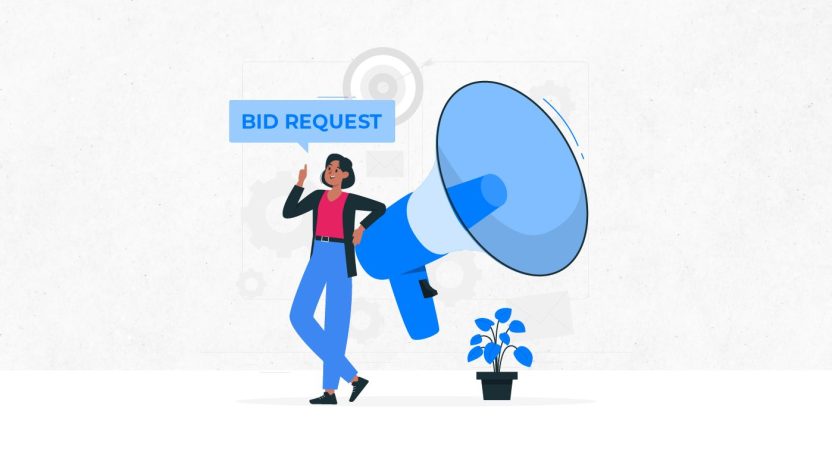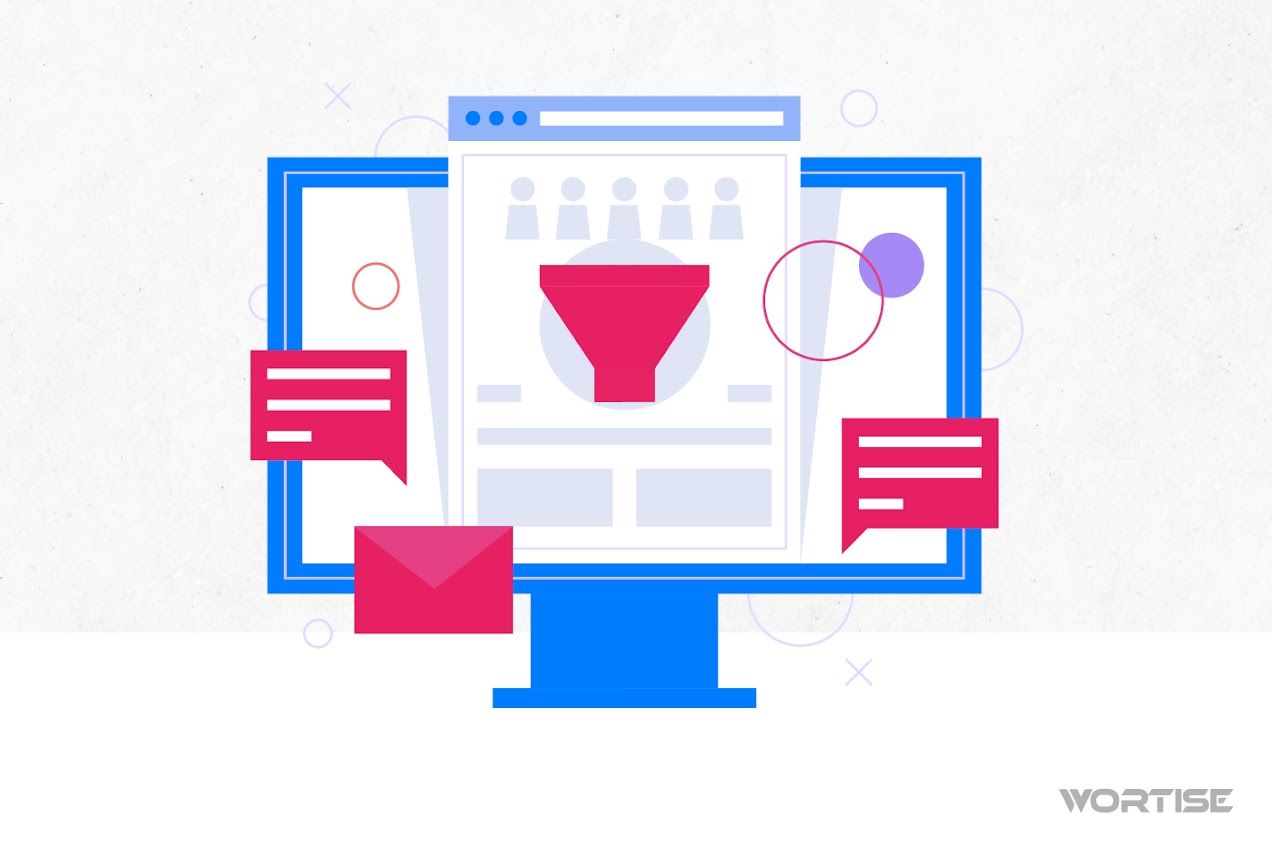La publicidad digital es cada vez más dinámica y competitiva. Por ello, las bid request, también conocidas como solicitudes de oferta, se comportan como elementos importantes que ayudan a los publishers a impulsar la compra y venta de espacios publicitarios en tiempo real.
Como publisher, entender el funcionamiento de estas solicitudes te permitirá mejorar y aumentar la eficiencia de tus estrategias, así como maximizar los ingresos por tus espacios publicitarios.
¿Qué es una Bid Request?
¿Alguna vez has participado o presenciado una subasta? Ahora imagina que el producto o servicio que se ofrece por una puja son tus espacios publicitarios, tu sitio web o una app. En tal sentido, los oferentes son los advertisers que compiten por mostrar sus anuncios en dichos espacios.
Las bid requests específicamente son señales que encienden esta dinámica de subasta digital. Son mensajes enviados por el ad exchange o sell-side platform (SSP), herramientas de compra y venta de medios publicitarios dirigidos a múltiples demand-side platforms (DSPs). Con la intención de informarles sobre la oportunidad de pujar por un espacio publicitario específico en tu plataforma.
Dentro de la publicidad programática también hay otros conceptos asociados, entenderlos provee de un mejor manejo de este contexto:
¿Qué es un ad request?
Se trata de otro mensajero digital que contiene una señal, una solicitud, que va directo a la plataforma de intercambio de anuncios. ¿Qué es lo que solicita? Traer un anuncio que sea compatible con el espacio publicitario vacío en una página web o aplicación móvil.
Esto sucede cuando un usuario visita una página web o usa las app de su teléfono y se encuentra que tienen espacios en blanco, los cuales están reservados para anuncios. El ad request le dice al servidor de anuncios: «¡Necesito un anuncio aquí mismo, lo más pronto posible!».
Las solicitudes de anuncios juegan un papel fundamental como piezas del rompecabezas en la publicidad digital. Son esenciales para que los anuncios correctos lleguen a las personas adecuadas en el momento adecuado.
¿Qué es un bid response?
Una bid response o respuesta a la oferta es el resultado que notifica el anunciante a la bid request de un editor. Cuando un advertiser decide que los espacios publicitarios ofrecidos a través de una solicitud de oferta tiene las características que necesita para su campaña, puede responder con una oferta a través del sistema de real time bidding.
La respuesta del advertiser a la bid request incluirá detalles de la campaña publicitaria, características del público al que se dirige, datos del postor, entre otros.
¿Qué es un RTB?
Una RTB, que en sus siglas en inglés significan ofertas en tiempo real, es otra subcategoría de la compra programática de medios. Y hace referencia a la práctica de comprar y vender espacios publicitarios de forma inmediata, es decir, “en tiempo real” a través de una subasta instantánea. Esto suele verse facilitado por una plataforma del lado de la oferta (SSP) o un intercambio de anuncios.
Un SSP es un software que permite a los editores vender impresiones de anuncios gráficos, móviles y de vídeo a compradores potenciales, de forma automática y en tiempo real. Esto incluye intercambios de anuncios, redes y plataformas del lado de la demanda (DSP), lo que brinda a los editores un mayor control de su inventario.
Análisis detallado de una bid request: ¿Qué hay dentro de este código?
Como te habíamos mencionado, las bid request son señales en forma de código que contienen información relevante sobre los publishers para los advertisers. Específicamente comparten los siguientes datos:
- Identificación de la bid request: se trata de un identificador único asignado a cada oferta para identificarla.
- Detalles del usuario: incluyen datos como la ubicación del usuario, su edad, sexo, preferencias, incluso su historial de navegación, etc. Los anunciantes pueden utilizar esta información para estrategias publicitarias más adelante.
- Canales de acceso del usuario: proporciona información sobre los dispositivos que usan los usuarios, el tipo, el modelo, el sistema operativo y más durante la visita del sitio web.
- Aplicación: las ofertas de anuncios para aplicaciones incluyen información como ID de aplicación, tipos de contenido, ID de editor, etc.
- Extensión: muestra información adicional relacionada con el inventario para plataformas del lado de la demanda y anunciantes.
- Datos sobre el sitio web: contenido, ID del editor, cuál es el nombre de dominio, contexto de la página como la información que pública, entre otros.
- Tiempo: el tiempo que transcurre en el recorrido del usuario dentro de la plataforma, desde que ingresa hasta que termina su sesión.
- Etiquetas y píxeles: una etiqueta, a menudo conocida como píxel, es una pequeña pieza de código JavaScript (JS) que se utiliza en marketing y publicidad para recopilar datos sobre los visitantes de un sitio web y sus actividades.
- Información Detallada: La bid request contiene información crucial sobre la oportunidad publicitaria, como ubicación del anuncio, el tipo de anuncio (banner, video, etc.), presupuesto del anunciante e incluso métricas de rendimiento históricas.
¿Cómo funciona una Bid Request?
Cada vez que un usuario ingresa a una página web se inicia este proceso de forma automática. Una vez estando en el portal o plataforma digital se activa la solicitud de oferta.
A través de este proceso rico en información de valor para los advertisers se incluyen diversos datos, como las características demográficas del espectador, cuál es su historial de navegación, la ubicación y las visitas a la página del sitio web.
Acto seguido, la bid request va del sitio web del editor a la plataforma donde se realizan los intercambios de anuncios, la compra y venta de espacios publicitarios. Es ahí donde envía todos los datos recaudados de los usuarios a los anunciantes, quienes a su vez envían ofertas automáticamente en tiempo real para colocar sus anuncios.
Los anunciantes dan sus ofertas por anuncios según sus impresiones y a medida que se publican. Como en cualquier puja o subasta, el anunciante con la oferta más alta gana la impresión, o el espacio publicitario, y el anuncio se muestra en el sitio web del editor (posiblemente el tuyo).
Se trata de un proceso que ocurre igual y tantas veces como espacios publicitarios tengas en tu plataforma digital. ¿Qué tan rápido ocurre esto? Las transacciones de ofertas en tiempo real generalmente ocurren dentro de los 100 milisegundos (incluida la recepción de la solicitud de oferta y la publicación del anuncio), tan rápido como un parpadeo. Todo esto desde el momento en que la plataforma de intercambio de anuncios recibió la bid request.
Dado que todo esto ocurre tan rápido y las ofertas se realizan de forma autónoma, los anunciantes controlan el presupuesto que pueden asignar a estas acciones estableciendo ofertas y montos máximos para una campaña publicitaria.
Ventajas y desventajas de las bid request
Las bid requests son la base de la publicidad programática, donde los editores y anunciantes se conectan en tiempo real. Algunas de sus ventajas y desventajas están:
Ventajas
- Editores con más ingresos: e
s tan sencillo como una ley de oferta y demanda. La oportunidad de llegar a más anunciantes te abrirá las puertas de obtener mayores ingresos por tu inventario de espacios publicitarios. - Mayor relevancia para los usuarios: las bid request también favorece el desarrollo de experiencias publicitarias orientadas a los intereses de los usuarios, haciéndolos más relevantes. Todo esto gracias a que estos códigos contienen datos de gran relevancia de los usuarios.
- Anunciantes más eficientes: las solicitudes de oferta permiten ahorrar tiempo y dinero, gracias a la automatización de procesos de compra y la asignación de montos máximos para la puja. De esta forma pueden llegar a una audiencia más amplia a través de una única plataforma.
Desventajas
- Preocupaciones de privacidad: dependiendo de los países cada vez hay más reglamentos que buscan regular la recopilación de datos de los usuarios. De igual forma, cada vez hay más usuarios informados que protegen sus datos y se preocupan por la privacidad de sus acciones en línea.
- Fatiga e intrusividad de los anuncios: la segmentación y la falta de control sobre la automatización de los anuncios impiden hacer seguimiento de cuántas veces verá el mismo anuncio un mismo usuario. Por lo que este puede encontrarse con la misma campaña reiteradas veces en distintas páginas web, generando fatiga publicitaria y una experiencia negativa.
- Complejidad y problemas de transparencia: El sistema de puja por anuncios en tiempo real puede resultar difícil de entender, haciendo que sea complicado para los editores y anunciantes la comprensión completa de cómo se está asignando el valor de un espacio publicitario y cómo se están entregando sus anuncios.
Preocupaciones sobre privacidad y soluciones
Las autoridades locales de cada país y los usuarios cada vez más informados están empujando la privacidad de sus datos a regulaciones cada vez más rigurosas. Un hecho que afecta a las bid requests que pueden contener información muy específica como la dirección IP, el historial de navegación, los intereses y las preferencias del usuario.
Aunque son datos de valor para los advertisers, también genera preocupaciones sobre la vigilancia y el uso indebido de datos personales. Porque, muchas veces los usuarios no son conscientes de la cantidad de datos que se recopilan y comparten a través de las bid requests. Un escenario que puede generar desconfianza en la publicidad digital.
Soluciones para la privacidad
Algunas soluciones para la privacidad de los datos pueden ser:
Consentimiento del usuario
En el mercado publicitario se están implementando mecanismos de consentimiento claro y transparente, con la intención de que los usuarios puedan controlar qué datos se están entregando con sus interacciones a través de las bid requests.
Seudonimización y anonimización
La primera busca hacer más complejo el proceso de identificar o atribuir ciertos datos a una persona en específico, mientras que la segunda impide que una información pueda ser relacionada con una persona física. Ambas técnicas se utilizan para el tratamiento de datos personales recopilados por las bid request.
Segmentación contextual
Se trata de otra forma de dirigir los anuncios, en lugar de usar información personal de los usuarios, se enfoca en los datos de las página web o aplicación de los publishers.
Colaboración con socios confiables
En ocasiones, los advertisers tampoco tienen claro o carecen del control total de sus anuncios. Por eso es importante trabajar con ad exchanges, SSPs y DSPs que estén comprometidos con las mejores prácticas de privacidad de datos.
Adoptar estándares de la industria
Implementar estándares como el GDPR y el CCPA para garantizar el cumplimiento de las regulaciones de privacidad de datos.
Las mejores prácticas para publishers en la gestión de las bid request
Las bid request te ayudan a ti como publisher a desempeñar un papel importante para lograr el equilibrio entre rentabilizar los ingresos publicitarios y ofrecer una experiencia de usuario agradable. Entonces, ¿cómo se puede lograr esto? Con estos consejos:
1. Mejorando la calidad de las bid request para ofertas más altas
Para aumentar las tasas de oferta, concéntrese en mejorar la calidad de la información en sus solicitudes de oferta. Cuantos más datos proporcione a los anunciantes, mejor podrán orientar sus anuncios y es más probable que realicen ofertas más altas.
Optimice sus solicitudes de oferta incluyendo información detallada del perfil de usuarios que ingresan en la plataforma, datos relevantes sobre el inventario de anuncios e información adicional que pueda ayudar a los advertisers a tomar decisiones informadas y mejorar su rendimiento.
2. Garantiza la precisión de los datos en las solicitudes de oferta
La precisión es fundamental en la publicidad programática, por eso valida tus datos y revisa periódicamente la información que ofreces a tus advertisers sobre el perfil de tu audiencia y tu inventario de anuncios para asegurarte de que sea precisa y esté actualizada. Manténte al día con los intereses y las preferencias de los usuarios, dado que estos cambian constantemente, por lo que es importante actualizar sus datos con regularidad.
3. Aprovechar el formato y la ubicación de los anuncios para obtener tasas de oferta más altas
La experiencia que ofrece tu página web o tu aplicación móvil también es de valor para los anunciantes. El formato y la ubicación de tus espacios publicitarios pueden afectar significativamente las tasas de oferta, ya que es más probable que los anunciantes respondan con mayor inversión por ubicaciones que ofrecen mejor visibilidad y participación.
Para esto puedes experimentar con los diferentes formatos, tamaños y ubicaciones de anuncios de tu sitio y así encontrar aquellas combinaciones que producen los mejores resultados. Pero esto es un trabajo constante, supervisa y analiza continuamente el rendimiento de los bloques de anuncios para tomar decisiones basadas en datos sobre la ubicación de los anuncios.
4. Aprovecha los datos de la audiencia
Puede que los datos de la audiencia desempeñen un papel crucial en la bid request, ya que los advertisers utilizan esta información para diseñar campañas enfocadas en los intereses y preferencias de los usuarios.
Recopilar de forma proactiva y cuidadosa los datos de audiencia propios a través de formularios de registro, encuestas e interacciones de los usuarios con su sitio web, podrán ayudar a satisfacer las necesidades de privacidad y de información necesaria para las campañas.
¡Atención Publisher! Aumenta tus ganancias publicitarias con Wortise
Nos gustaría impulsarte para que puedas aumentar el rendimiento de tu inventario de espacios publicitarios. Con Wortise lograrás alcanzar a un gran número de advertisers y así monetizar de forma segura tu página web o aplicación móvil.
Actualmente podemos ayudarte a conectar con más de 200 anunciantes a nivel internacional y también ponemos a tu disposición una amplia red de Ad Networks.
¿Estás listo par
a dar el siguiente paso? Te acompañaremos en todo el proceso, lo que requieras en un soporte personalizado para comenzar a monetizar tus plataformas con Wortise.




